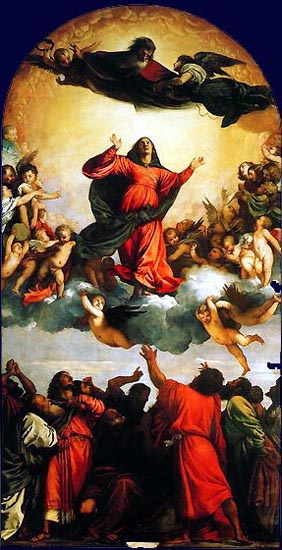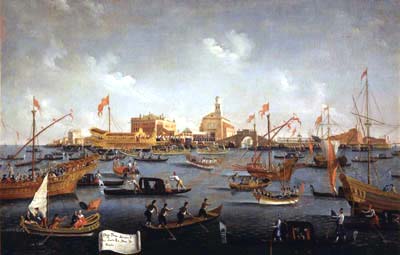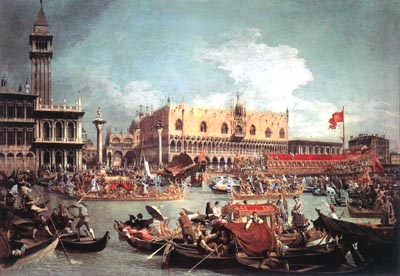jp

Storia di Venezia,
Biblioteca

|
The Festival of Our Lady of the Assumption in VeniceThe Wedding with the Sea |
|---|
Errata Corrige 6th January 2014
a whole set of
historical evidences, produced today by the independent researcher Mr. Marco Girardi forces to rectify the Mr. Giorgi's article previously published, and the version usually known about the origin of the "Marriage of Venice with the Sea".
Along with two chroniclers from XV and XVI Century, Sabellico and Doglioni, the fugitive Pope Alessandro III did not honoured Venice with the sacred ritual of the "Marriage with the Sea" after the Peace with Frederic Red Beard obtained thank to the Diplomatic efforts of Venetian politicians.
That Sacred Honour came to the Venetians right after they won a Naval Battle against a much superior fleet, formed by ships from Genova, Pisa and Ancona, serving the Emperor Frederic.
That Monarch did move war to Venice's Republic just cause of the hospitality offered by the Serenissima to his enemy, the Roman Pontifex.
The following Peace did not came cause of diplomatic ability, but thanking the fact that in that Naval Battle the same Frederic's son, Ottone, was captured. Thank to the generosity of the Venetians, the son was sent back to his father as a Peace Ambassador.
The boy was able, along with the chronicles, to convince his father that the Venetian Victory on the Sea was dued to a direct Will of God, being the Venetians with only 30 ships against the 75 of the Emperor (Doglioni reports "85"). 48 were captured and brought to Venice, including the one of Ottone.
The Emperor was so inclined to submit himself to the Authority of the Pope, which then happened as is usually traded.
The narrative by the chronicles about the Battle, told of "Salvore" or "Salbore" by the name of a Istrian Promontory near the event, is also confirmed in the pictorial historiation of the Maggior Consiglio' Room in the Ducal Palace of Venice.
Another Author ascribes a similar version of the facts to the chronicler Dandolo, but we could not yet verify this.
The ritual sentence pronounced by Alexander III to the Doge, while consigning him the golden marriage-ring, as reported by Sabellico:
"Receive this, you Ciani, by my Authority, with this pledge you will make the Sea subjected to you, and every year you and your Successors will renew this ritual, so that it will be universally recognized that the lordship of the Sea is yours by war reason, and like the woman to the man, the Sea will be as your Domain.".
We note that Sabellico names the Doge Sebastiano - Ciani - and not - Ziani - as commonly used today.
Umberto Sartori
|
 |
One of the oldest Venetian ceremonies, the Festa della Sensa, celebrates the naval power under Doge Pietro Orseolo. It began in the year 1000, when the naval fleet of the Serenissima - the Venetian Empire - departed on Ascension Day to attack Dalmatian pirates who were threatening the Istrian coast.
The Venetian navy´s famous victory over the Slavic pirates was the beginning of the rapid expansion of the Serenissima´s political, commercial and military influence on the Adriatic Sea.
The celebration of the Sensa began rather simply, as a procession of the the Doge upon the Dukal Galley (that lately became the famous Bucintoro), would be followed by a fleet of boats to the entrance of the port at the Lido, where the Bishop of Olivolo (Castello) blessed the waters of the Sea in peace and gratitude.
The same anniversary was used to remember successive important diplomatic triumphs, and the ceremony became more complex and dazzling.
In 1177 the two largest European powers of the period signed a peace agreement in Venice which ended the long struggle between the Papacy and the Empire.
|
|
This came about principally due to the diplomatic involvement of Doge Sebastiano Ziani.
Pope Alessandro III, as a mark of his gratitude to the city, gave the Doge a blessed ring, pronouncing "Ricevilo in pegno della Sovranità che Voi e i successori Vostri avrete perpetuamente sul Mare" (Receive this ring as a token of sovereignty over the sea that you and your successors will be everlasting). He then imposed the wedding between Venice and the Sea "Lo sposasse lo Mar sì come l´omo sposa la dona per essere so signor" (Marry the sea as a man marries a woman and thus be her Lord).
|
|
From this moment, the simple ceremony of the Sensa became a major - and very popular - representation of the myth of the Serenissima, "Queen of the Seas".
Once each year, the Doge would "marry" the Sea, and throw the Blessed Ring into the lagoon as a sign of eternal fidelity.
To consolidate the Sensa as one the major anniversary celebrated in the Republic´s calendar, another Benefit came from the Pope.
|
 |
|
The Pontiff, indeed, was grateful per la poderosa assistenza e per il cortese ospizio donatogli nella persecuzione da esso patita per Federico Barbarossa Imperatore (for the great assistance and hospitality he was offered during the persecution he suffered under Emperor Federico Barbarossa), and thus granted indulgences to all who visited the "Ducal Chapel" (the Basilica of San Marco), in the eight days (later 15 days) following the celebration.
|
 |
The religious incentive to get God´s forgiveness brought every year more crowds of pilgrims to the lagoon for the celebration of the Marriage to the Sea.
The venetian character, inclined to combine the Sacred and the profane, carryed to initiate, in 1180, the Fair of the Sensa, with displays of the best local handmade products, and merchandise from the Orient.
|
|
At first the fair was organized on wooden boats, but later it was guested in the St Mark´s Square; later on, (in 1534) Sansovino architect was commissioned to build an enclosure of woodden shops, to be setted up in St. Mark´s square during those days of the feast. The Fiera rapidly became one of the major European exhibitions.
The Festa of the Sensa continues today, albeit in a much smaller fashion. On Ascension Day the Mayor, aboard the "Bissona Serenissima" (used in the parade of the Regata Storica), flanked by other boats from the Venetian Rowing Societies, moves to the mouth of the port of San Nicolò, near the Lido. There, he throws the gold ring into the waters to symbolize the eternal union between Venice and the Sea. In some years - but infrequently - the Fiera of the Sensa is set up again using the same painted enclosures that can be seen during Carnival in campo Santo Stefano.
Sebastiano Giorgi
|
TOP
|
|

